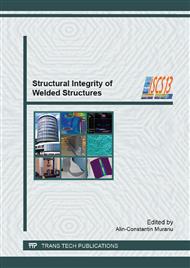p.173
p.180
p.187
p.193
p.207
p.214
p.222
p.230
p.235
Deconstruction of Existing Railway and Highway Bridges
Abstract:
The paper presents the damage under time dependent actions, fatigue, creep, corrosion for a railway bridge and a highway bridge. The first one is situated on the IV Pan-European Corridor, which crosses the Romanian territory. Although recently rebuilt, in the end of 80s, the bridge’s superstructure, made of decks with twin plain web girders, was in an unsatisfactory condition - loss of load bearing capacity and missing structural parts (strong corrosion and cracks). After the stress analysis and the fatigue verifications based on the Wöhler concept which were made in relation with the prescriptions of the Romanian standard SR 1911-1998, Swiss code 161 & SBB Richtlinie 2002 and the German code DS 805-2002, a life prediction analysis based on fracture mechanics principles was performed in order to evaluate the remaining fatigue life for this structure for the new traffic UIC conditions; in conclusion, the superstructure should be replaced. The highway bridge is the only crossing possibility over the Bistriţa River, parish Frânceşti, being an important element for the road infrastructure in the area. The current bridge was meant to be a temporary structure, but due to economic difficulties it wasn’t replaced. It does assure the clearance and safety according to the standards. Based on the technical situation of the existing bridge the replacement of this structure is a necessity. Taking into consideration the need of a simple technology, the limited construction height and a very short erection time, it leads in both cases to the necessity of a modular system with low costs. In this area of application the VFT-WIB® solution with its roots in the classical WIB composite structure was developed.
Info:
Periodical:
Pages:
214-221
Citation:
Online since:
September 2013
Authors:
Keywords:
Price:
Сopyright:
© 2013 Trans Tech Publications Ltd. All Rights Reserved
Share:
Citation:


